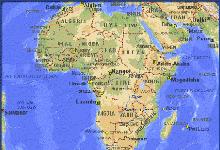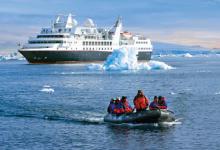Recently Viewed Cruises
- Silver Explorer, Voyage 7307 ex Cape Town to AccraAdd to favourites
- Explorer, Exploring Africas West Coast ex Cape Town to AgadirAdd to favourites
- Quest for Adventure, Echoes of Colonial Africa ex Tema to FunchalAdd to favourites
- Opera, Ocean Voyage ex Cape Town to GenoaAdd to favourites
- Opera, Cape Town to Italy ex Cape Town to GenoaAdd to favourites
- Royal Caribbean International raises the bar
- Classy Astor fills gap in market
- Oceanic Discoverer
- Ab Fab Oosterdam
- Catch up on Cruising: Latest cruise news in bite size
- Frequently Asked Questions
-
Silver Explorer, Voyage 7307 ex Cape Town to Accra
Nights 18 Ship Silver Explorer Star Rating Specialty Departs Cape Town, South Africa Sailing 2013: 24 Mar Ports of Call Cape Town, Luederitz, Walvis Bay, Lobito, Luanda, Sao Tome, Bom Bom Island Resort, Kribi More Limbe, Cotonou, Lome, Accra Please enquire about this cruise for pricing.
18 Night Cruise sailing from Cape Town to Accra aboard Silver Explorer.
Silversea's purpose-built Silver Explorer expedition ship (formerly the Prince Albert II) has been designed specifically for navigating waters in some of the world's most remote destinations, including both of earth's polar regions. A strengthened hull with a Lloyd's Register ice-class notation (1A) for passenger vessels enables Silver Explorer to safely push through ice floes with ease. A fleet of Zodiac boats allows Silversea Expedition guests to visit even the most off-the-beaten path locations and an expert Expedition Team provides insight and understanding to each unforgettable Silver Explorer cruise adventure.
Onboard, savour a convivial cosmopolitan ambience and many special amenities usually found only on larger ships, including a spacious Library with an Internet Cafe, boutique shopping, a full-service spa, beauty salon, fitness centre, sauna and two top-deck whirlpools. Prince Albert II even features live evening entertainment and The Humidor, where connoisseurs can enjoy the finest cigars and cognacs - diversions offered by no other expedition ship.
Highlights of this cruise:
Cape Town
Cape Town and surrounding regions are regarded as one of the most beautiful regions in the world. The city is a rare cultural gem resulting from the amalgamation of Indonesian, French, Dutch, British and German settlers, the local Bushman and Hottentot tribes and the Bantu tribes from the north.
The impressive presence of Table Mountain, flanked by the legendary Devil's Peak and historical Signal Hill, stands proudly above the city. Beautiful white sandy beaches along a peaceful coastline frame the Cape Peninsula.
Cape Town boasts a multitude of entertainment, ranging from outdoor activities and adventures in the sun to a roaring night life under neon signs. The vast range of shopping opportunities includes haggling with shopholders at Greenmarket Square Flea Market, as well as breezing through sophisticated and stylish shopping malls. The huge variety of restaurants reflects the multicultured history of the Cape and caters for everyone's taste, from fast-food outlets and casual to the chic to the very elegant.
Walvis Bay
Formerly a whaling station, Walvis Bay has become the principal port of entry into Namibia. In 1795, while occupied by the British, Walvis Bay was turned into a naval base in order to monitor and intimidate the empire's European rivals during the so-called "scramble for Africa". When Namibia gained independence in 1990, Walvis Bay and the surrounding enclave remained part of South Africa until February 28, 1994. On this date, the enclave was transferred to Namibian control, ending a long disputed claim between the two countries.
The town is built for the harbour, with numbered streets forming an unexciting, but easily navigable grid around it. The city centre can be covered on foot. Of special note are the municipal buildings, decorated with attractive wood carvings from Namibia's Kavango region. Exhibits at the local museum illustrate the history of the town and the indigenous Topnaar people. The lagoon on the outskirts of Walvis Bay is home to a bird sanctuary. Flocks of flamingos and pelicans feed here in the nutrient-rich water. The lagoon also supports an important salt industry.
The resort town of Swakopmund lies 24 miles (38 km) north of Walvis Bay. It was under German domination until 1915. With Walvis Bay under British control, the German authorities tried to develop their own interests by establishing Swakopmund as a port, but without much success. When German rule was surrendered to South Africa, all trading returned to Walvis Bay. Before independence, Afrikaans, English and German were the official languages. Following independence, English became the official language, with Bantu and Khoi-San the main ethnic language groups.
Walvis Bay is a good starting point for excursions into the desert and dune regions, offering visions of unspoiled landscapes, compelling beauty and a feeling of unconfined space.
Sao Tome
São Tome seems to embody a kind of lush tropical paradise usually associated with the South Pacific. The atmosphere here is palpably luxury and it is an intoxicating blend of sunlight, sea, air and fantastically abundant vegetation.
São Tome and Principe is a Portuguese-speaking island nation in the Gulf of Guinea, off the western equatorial coast of Africa. It consists of two islands: São Tome and Principe, located about 87 miles (140 kilometres) apart and about 155 and 140 miles (250 and 225 kilometres), respectively, off the northwestern coast of Gabon. Both islands are part of an extinct volcanic mountain range.
São Tome, the sizable southern island, is situated just north of the equator. It was named in honour of Saint Thomas by Portuguese explorers who happened to arrive at the island on his feast day.
São Tomean culture is a mixture of African and Portuguese influences. São Tomeans are known for ussua and socope rhythms, while Principe is home to the dêxa beat. Portuguese ballroom dancing may have played an integral part in the development of these rhythms and their associated dances.
Tchiloli is a musical dance performance that tells a dramatic story. The danço-congo is similarly a combination of music, dance and theatre.







